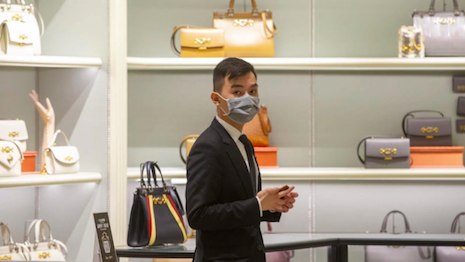By Abhay Gupta
As the world locks down due to the coronavirus pandemic, brands, businesses, societies and consumers alike are undergoing a traumatic experience.
Daily lives have changed dramatically for most of us – those facing customers, those behind desks and those out in the field. None is spared of this life-threatening and devastating turning point in the history of human kind.
Where to turn?
Brands everywhere have to make difficult decisions on how they will support compliance with local regulations and closures, continue to serve their customers, and strategize on how to emerge stronger after all this is over.
For many, this means that large populations of employees – including those who work at headquarters and store support centers, store associates and distribution workers – are faced with new types of working, including working from home.
In such a scenario, luxury and fashion are not obviously necessary to preserve life. For sure, today, a steak is actually a much more vital resource than a dress.
However, the economic contribution of sectors such as real estate, fashion, fine dining, and watches and jewelry cannot be discounted.
What can a brand do to remain relevant during these testing times? How does it maintain mind share to be able to bounce back once this is all behind us?
Here are few tips that could be useful to adapt now. If you can effectively reinforce your culture while supporting these changes, you will emerge stronger than before.
Focus area: New and existing customers
- Keep in touch, connect and engage with your current clients.Get a feel for their business right now and assure them that your services will offer (X), or be available for (Y), or that your products and services are currently unavailable until at least (Z). Whatever the case might be, it is important that you keep your current clients in the loop.
- Do not stop prospecting.Cutting down on your marketing now is not a good choice. However, keep in mind that now is not the time to be “loud” in your outreaches. Do not hard-sell, be compassionate and display sensitivity to what is currently happening in the world.
- Increase your messaging output.Top sellers should actually increase their messaging output rather than decreasing or maintaining the current rate. This ties back into the previous point: do not stop prospecting, and actually increase your output wherever possible to maximize your chances for success.
- Provide in-person experiences to select customers.Use this to reinforce relationships with your best customers – whether this is virtual, in their own home, or in store. As long as safety precautions are met, this can go a long way in maintaining your bond with customers.
- Offering “video personal shopping,” “virtual walkthrough” or “3D simulations”: If your store is closed, make phone appointments available so your talented people can provide the next best thing to “being there.” Offer virtual a walkthrough experience through your apartment. A 3D simulation is a great tool to adapt too.
- Accelerate your digital experience.Over-communicate on all aspects – store closures, hours, special programs, promotional offers and overall customer experience, so that customers do not forget your brand and also continue to experience the brand the same way they always knew and loved.
- Reinforce your culture – virtually: Most who work in customer-interfacing roles are by nature good humoured and friendly. They survive on their daily dose of engagement with fresh and existing customers. This eventually becomes the culture of any retail-led organisation. Continue to do the same via video-selling facilities, virtual trunk shows and online fashion shows.
- Understand your clients better: deep dive into CRM data. This is the best time to upgrade, understand and improve upon ways of capturing client data. Go into minor details, irritants to staff and clients alike, and bring in new technology to ease the customer journey.
Focus area: Product improvement
- Build up design depository: Use this isolation period to build up and enhance your product design depository. With more customers seeking personalization, this is the best time to amalgamate front-end feedback about each individual client and build up a personalized design offering for her in advance. Surprise her when you re-open.
- Revamp your existing inventory: Recycle-upcycle-crosscycle seems to be the trend. Evaluate and reposition existing inventory in a fresh perspective.
Focus area: Brand development
- Prepare for the future: digitize and thrive. The future being virtual, develop capabilities, resources and assets to boost digital presence. Artificial intelligence (AI), virtual reality (VR) and augmented reality (AR) is at our doorsteps. The current pandemic is going to change the way we will work.
- Offset lockdown with ecommerce Rise of ecommerce is but natural after this crisis and lead to increased R&D, allowing for an equally direct relationship with consumers online as it is offline. With ecommerce, brands will also gain more control over inventory and personalization.
- Sustainable luxury. When it comes to sustainability, many luxury brands are still only skimming the surface. Things are likely to change with a common perception doing rounds that the coronavirus is nature’s way of directing mankind to “step back and introspect.” Luxury businesses must empower luxury consumers to understand, follow and control their own impact for more responsible consumption of luxury.
- Research and check on competition. Take a calmer look at competition, their operations, processes, product and teams. Be aware.
- Improve – improve – improve. Use the above-mentioned research to update, recreate, revamp and overhaul processes, systems, tools and capabilities.
- Action plan 2020-21. A strategic plan with overall improvements and a business plan to hit the road running once all this is behind the brand.
Focus area: Team development
- Listen and be empathetic.Your teams will react differently based on their own situations. It is key for each individual manager to have open discussions with their teams – both in group settings and in one-on-ones. No topic should be off-limits.
- Empower your leaders: do not micromanage.Give your managers enough authority to approve equipment that is needed to boost productivity. Determine loosely what your policy will be – and then let the managers put it in action. Better yet, push rational decision making down to the individual.
- Knowledge upgrade. Research, strategize and upgrade skills. Prepare for the new future, a new way of life and a new way of working. Join courses, programs and webinars. Encourage your teams to do so as well.
- Challenge your teams to learn new systems quickly.Make it competitive – and provide awards and recognition as a result. Use this as a way to catch up on required training.
EITHER WAY, the answer here is not to sit back with your feet up.
So, while these times are nowhere near “business as usual,” let us do our best to continue doing great work in the areas we can control.
And if we all do our part, we will get through this together. After all, one needs to shape up or ship out. There is no other choice.
 Abhay Gupta is founder/CEO of Luxury Connect and Luxury Connect Business School
Abhay Gupta is founder/CEO of Luxury Connect and Luxury Connect Business School
Abhay Gupta is founder/CEO of Luxury Connect and Luxury Connect Business School, Gurgaon, Haryana, India. Reach him at [email protected]. He is also author of the book, "The Incredible Indian Luxury Bazaar." For further analysis on the Indian luxury space, its consumers, challenges solutions and more, pre-book your copy at a special early-bird price.
{"ct":"w74cDStKmiXyIv3hvBO6JqSFAyj95bUdmNPlXf\/WGLaQF1wdc5WKP7qxk4VFCkY5nhCbqmMpenSxTOV3lvm6IKxBPK5eBjMRdkejqo9JlrGJssfVOwhNaKAZ+LawDfaNxQhzWY46DBXCJrWxltdrL49NrvxTB2LyBooz3EdH+9kXCHB86Mv66kJiWn2UxREBHvUgbRMrs0FqYX\/lbSDe\/hgpRshPhYOcc\/L29A\/EhKTwT6UHHfUZbJ5Pzmaxq9cxxjFbkfO7WglKPE2Vf4qk0q6FBqaYmPJjJO0LWqArpkxuRHrCtUGusiLwOGmMI0DOrZMQyVCEdnJCsRMPSxq9hH5vQ4pydFJCFKY\/72gQ3jUHr96piNY8NX6mziCVf2rRDABGxEq\/nWwLgEkFqowsf1+XY\/9z2AopbiVjyc1vrMhpcrStCeSX3uqqv5L2HeBaQzsLIuQ2cVprf2ofT5Zeab6pgBL645LEeMA3xHMM4HNZStSLgTkP5gExh1xAo3C+NmRxYAbOdOyRqdv30dKlT7OJPla+7lDFEcqP9RhW6\/M0Ips2KfezEkfgUATalZsOKpBCXSJjdb\/Yn5llXI+rm3wpFiy9xLZ6zkpReQw7Uvuh\/KGFm2bHg\/h9Eb3dmj4xsuv\/zR0Z9ru8oJ\/QUgC+d6+dK5WR4cRoj3I0zsuCJeiPr6nQVQSZLzLJAXV4lfsZQJ+Qa+RNkfIxI8ezKM6MXXSkNLSgGyVLAVNM0UnxI1tJY0SGzaMRZSaLYR5gI\/gJF4U0n8TOc+nNmPLHWVgwe7yMfWcaoTBzDGS7KIX2khbnyWi0G2K4Y1JNKEOUeGh+NSW3HlPpdx50wUGEfD0dlkxro6PNGL+btwoL9qrBW7h7cuY1HEJtMt80AvUk+s\/RBcQT1rO2DbQ\/498fGJQr02sVI2PyFyR8MPtIt+5rkZNYA30X9kR7YwGBy8cHDPDcFViNUMQWvutwY04v94MtCcOyVszKFFByU90IaJahb3M3F+CvEMi9wADwQpH+Z3lNk11HwGs5GKxdYQMul1jN8CxAXzbZl6OluD+v2oM0LAP84+mGcuVxUERIXt0J6ddFrFCHATiHjdUiTGKsKpHiNeI+7tTP6NTisS+qlQSQPf\/ZYZfUT3fkzTN0Ydu2ymqQknHnWG1f5NgZsqRSQktYantv4tvv75nbJsaP424FcDny0mZuIohYIiVFePhVNVL0eMY+Evkzg0yoDI\/o37KrZNyY2+z3UoygW30Mcf0nBJmuaOLS7uorBFG+M6ZUB2keMLCxQPQ+eUMTeKq9gXHIWJg6Q2qn8foFQlyL9R8d96EuMBmfZSnIZ2oa65l82epw6xv2rpcPqNRgnKnBpVieagS9bR7VAPeBZCSzgAXVLSSynabl7uz8Ax1yPPdU04i723rMXFaDXB\/srguz5\/wfeH+Vr0zSh8yNB\/1YzzniySAlo90ZfW00mvUq029\/43WSlQfPXycQU5fFSNDi+SsBp0Uf3Y2WbfWx+r\/XpjKkUOBrsi8OPrFSih+x2SUerXYaWarRUIfYcR7b427HwdveDoySJmHYeFxPROzLJCjdlRFCNG5LLnLHlmLLJ0DLDbPKgPIsrNnNDkdaepN\/8nK4XeydIVbzsnKVNynXn70Ob4EVz7Dtk6tM\/Hd7g5z0V\/X2gA8lGpf8AZlziy9OVOyxJKvTq0cZw1aD1b3BQul4l32yFiyVTp57UPDgYE4qkfftQnI4MyETgWhcYBTII7AjH3XldMmOBci3IOg2KYEx7x91QS7itVaRCPWvvH6cnrRxSwJwnTogtNTXo9yDUNdsU+YMpIQYMiFsJ4vyvjs9EzXvQr23qT8Q+1MxSKpJPPUFPctW\/6H7GFOAro9SeHxblk7zjZB6nKxvOI52uNMqjUncFAGE0CoNYYuhz7+lLmFpURUTmwtf\/wupkH23jzKr7vOzZ41wUe7cHLNDo74+WWQ9so46Lol4eyd7lW02M4qGbpn6uyITOwlJOlxey7p2NN9a+qDYq+DJmqkkYdKSbDMmdl+lcvh7O2r2p2LmbhyiyNcJETyeE5mpdgBoPvwTq56+6G11KCA\/CFTqECuaMeCQJlvwh04528MjTlfWPL+iKht2mPYRJv0fg+sGUdX4tnnIMHVn817qqAr4NbbUAiSz0ClJdHTVKaWe6nH+He51dUwRfRxdZ0zzNhPaj21YWTAQjqAecsVIBXIX4MOtpdb\/VVYXuB0WMVr1xz94ZPqVJJeLBQClSkFwfFsT1gVgKqlc7M4vgbPzPWzJDKCXMasQsBmdxRqZRsUnEH\/axM4NVHfBU3HQbSNH2mQg4SaLkWec7WkH6UpshjjW3yXdMGjDJmtOI9Ce6gmj4L6iA9iHrqDPGcE+0E+4QO2FAWvSekp77dxEwRr9URmzoXYtUq\/IALxkhKn7\/Om0e3gDNq6L4ZkiHmN1RQO1JcOT+\/85kK2TRziUDE4zkSrAHA\/i7L10kQm7zMTmdB4s94bBjDJHyC57mZE+ZADxbWFyNUhsC60WvPr+H2irQDHY9WUans8yWaxUd2FW51tFuuB7JozjgELVuQTMqc+6Hp6kiZnp1iKA70jes28Oc7TrGBv7ULsLH8XRmHAXPWPT6VvG0ZFUDNqOF6YtNo6GvVPSEHm7B4LNhvTA2m9YUM\/5p6NlMIcPLTF8F4suKMPFY9NzoE0sOjN6HFi3y13PPW7EHw9xok+tnzU8krAnIuh\/rUIivVoGgzpIhc7A26zDEVCStBR6yqeFAfOEDW4\/8X5jN4MXPoLsUw6kG9fTxOJeOOsPQAPbOSDInkbmCgWYXY6bzM94yxop5QGtoQq66P+Sns1owP+JF64NgwNx+vLXcbM+LyJ7aUR8xLRpozKDHQdtf7FhDFZFtvEaGUftFCZ3WfmMpO5SNrPc3JKQsFDpKh4QRqGOb\/vVTaceAOLYJNdJKhS+blMb7+CGSjNbjoWTQMlPr33MBFGfsDCTJ3NjzFqdk1KtlUyqcobjtwp4lSKasR6vcLKzKNU1gQjoQBSH0\/lieuQ4ufF98LTWl6xiHzg\/l3XFI64HPGNLfRbo6vw1oWUZqaDmH+MrkzJuSpGeKWibYszh5KmcnQXIb97PmMHhm6uZqa\/zvHZjS5\/da83kbkFzCjsZbqElYp41wgED0omVHuco6a+A22IseY\/n8RijO+Cj+CTpAs\/fT92O+yEy9HqW4NIypd8saWY2SC2DBQm3sasV\/K0ckR7PREgv\/PXi2A354mZPLobxmRlkZ18wyYk7MHKNnBnBCZEmrQ8\/6cPXgmrHWsVjpbnGqMBbh3DVgJof0eWF5WeKesjjJfhPznWW\/PdRHwtnwgYklieJHeJt0Z\/gvMNbQtKIGMHICwPuwEtxIoE5h5c002QitplpxMNwa5RMVC7MECattSVfGVHXeSXwnGl+vNas8HHIMUdasJ7cnFe2pJBCeSTbkBSHJhQHg+LLi5pULl4uiGwbIvEDFs2KgWwie662Lg9FN\/N3eON1AQylqKOe90WwaDhg9lZXrEjauqO4yOR46r25ubRaGyPuIHInzaebDLTJByObQ7Pbp\/LbFUO2pGl+gZOXVNulEOCBoXUVeXGchg+GkyCMgqZpjmX5A7WrOr1YHdgmOkd1ZvBcLAWVplHjIWGtcqnSaRbPbUZttFtqV5701zB\/4n16ADI5DCMcU\/mCK0+xA3zEtPFcT7t6UhjQ6sq+0VEddoHzARtqH3fPSXtYD0QBg1aM9jAHLc5LIZNMCAOHExfIv93Jks\/TDL0LRjFwKRlzA0M7T+b\/MsZ2N7gwWhLrlg1pQGdT09ou2bu2NUv8DXWNMh7LouKaAxVfU8ICFRPcOUdWY8wQrI4q9GnEe\/WtF\/mtJfhpRiX0UK7vzD+Mo3ZRjMf8\/XvqMVCTVXm\/4FHj74yhmLJe6bK2YtOEJUniQYYI7Xlh8il4qJCqrJJA\/oQT+sJZP6EUbxoQeJW+AZSfTQQhLaGdcjcAcpN\/WGSdHHyfmWlSDK+HQsd71NUqHK2Y8858ugKS78wmB\/wSNOluwXB14g1ju6oTtjKk2zBrHPLUVc+PRCwM5Rf20rAAyj2+0S7XEgD6lPjSJ6wr1odjpnNvQuWJ32rk1yzOloG8BmwekqtvgkInob3kxe+StMcdI4sPt4ecPqEGtQ0\/cr5utEWYrIAbVzgJlDaJGyepIlY0Xq2N+SoTaOBNnbeMi9qXyRur684BYezesd0komGiYhZukC90ep8NHpLH2ybIet2ntjNJ+4DF2zGetO8mD\/zmjGT9aq6w3vghOyP3gKQBjhZsKzX8zww8YrZkz+CkyAdaEZntKDpZDoWpQMUQnd4wO3AUsUL+7mOlxlVj5GFlxcwpqldBoSyhs09SdIDWVy9l\/MFd\/1x2JshZMDsmIWkDTwanOoxouCHXedpEqHZDC10z933VOlQcIYkie5kMZy7W4AEokfGvNRkShvpeo01\/jzVYWLhgK+53uJByZz7KIQDlOGJYfz1Iezi5qZsxfNgjC0KWklNPSF0mU+1xUyVyFKFItiHMoMr52Ms4rQPD3rsD7fqbYFgT3HaecUqFshd8aDDqdtzbgzlzbblHOkwEfGGxHBCPoEg5pYFuxp2\/5A6MEMr7IQrEK69P3DJvDZ0fyee7tQk4IFQuVJxPAscTM6T2b4TZyE7uyCI2seJyxy7UEDTYMxD18w8uUAHJRPao25xuitqiAyUiLwDBYfbJTi1GCZAIR+99Bjr3ct28lM7oH5xnq8ZOijcWGouOb0RSkVMvF8SaZWpADcD41sd9pfdgFg3E4Zl1Q5BwL6Sc\/53mmiDSUFtWKJ+NEgOhJcJ3IEo4DwgoOq\/lj+0QePKt6ZBE411KrzTXWsBmTaxDior1p62VTQn1vu+pTKXPOmoqNAWhCF58Pf2lEUEUBz3Pv3cr92xIcYmsoxcPIWPxuHU0x3JouhrB9j7IHN1obMNCUWng7FJXJpiT3gQuqO+hTBIt9el060UX+AtucoBO2lrT4R2lY9Ap7KY8k6JstbYI7djUpwDeWYMtyL+TDANXO1HLcwhB333axLQI5Eis3Dm8Ck9vz46jRjQAZyjQkjTL+hgDcB5q0G\/92l9JSFL6WNzeAi2IS8suUls8Nuk5MzXuu2LnK6DDjJLokiOCvuBBoOtyOAu6g1xAEaAKgWKRcy9c74LrDlRGvNctY1oPZfh3TVpe5nj9u+F2vFlVWLzs6QrtsYX3pzQ\/ktp0Ip06K930dA63bKFuuRqH\/vcjee4ULwJa1gGUpXcZ30ySG\/s4yOUjvwE3GWRi\/\/yEUBH6tAh5jF1x+q3bXwNubh7N5iOR11LTvdZP7qRP7LQMqvBPwQmW3mV6SoLP4HaIGNh\/8AQ3yI9cv9XKHy+lNbc71\/MAtJplgcX0\/HnYQQXTgnDZLNsYEv0bn5qr5zDFDiD5L7KOJCGq1+Vd02W4MWKVDnZMwjUhttj9tYWShsH0B3rSRNSL5an\/+gGgOdQYhfaJIUSBuLhdpoyUH+byWWOzqkqvGOSIcJKKPR6s6c9ZDHjHELxt9tqwrMMjQVHUZhGHYzjsKgvVIZTUkcxZSOILXlKbh6xxOlMWC2pnsLtjrHUHCHc341OkQVHUCjkba\/3TLCu97Z6teT45ZOh2hvbFmnBmPOJs8DjFhB+apJ1O3t1KgHI2sM6ydP9Pb\/doJgt\/BCQEOjlV3yZ5xd6nMZttdvFf+0jBsHohyLaOYvCR72eJmVy90y5e6F1aN2Jg2GVweaTGXYmwIt6sKJkG\/8opPTiRNJkl01kMK73Z1A6OhX5puHpZ+Hw6OS8zX4J2Pzg6HURbadLb7L93w9i\/nkTsWEDM1qf\/EKUp5RyM9hyPuySvB+oxTBOWJEvBztG2oI8fuz+mveBpxUN8mD6bcoxe509l9yhPCB9DnJ9Fi4j99wuptmSsb0NFbkZ0dUgOoALy5StEX95KUkNp0fQJRQzkoqUcmanL1+UHKCs7aBvIHAxAFKrkbewPcn9CLzcT46UaaK+05vWCUNmAISdXdl7vX8lq8iF2faEJraVhYJvEA\/J79XdyJGNeo9pZ4uqktPojPHkY3LQPWy+Pz15cynuKQG7bymi\/SnIyXRqvm1UuHXbMnGM818CpeB1gtUAjNwpfui0Y2VDeT+CV7ufjhOq4SLAy1XM7AuNZbC71FRANhRkJSTJKFWvxqS7bRuEJXnKsbvR68HKeINqW1Vn2anI2pLbSNWkORCqmDPD6VE+O7KDAkswmOJ4v4tYXyBA8kqvFw5jkny9XmoHtSHAhkX2ia0BW31QHfseDuOdEBEA0pG08Rc3P5oe5k6DE3iDNV7W0u5IAsQP5KkqM2omwRDZOI54JHFd8Wm\/8DifiNWN9PAXZUJNliixNyP+6v76j+zEcirwo3SZ9qfHfk\/yCL4Nn7fTTVeFgxIfjCwcPVKn0X8WXiYQTjsJDcm66zEZmNWKKDFaBQEhoE6MZ5EbLG68fnmd2f5edg3LUUrEayPanffc4Zws7xps2FyOaGvHvaYg2Mr+f5WC5YplVJOsn08rlXYFtT2Ah5z7dNW14S6vze3vb0H+B5qLNAyMCAvNww07IzgOhNYvYsiMdihkP4Gg4g2zuayMJZcaFOT63RiaYUfQ8j6QJzBSurCb1RvFYPvZhS9TelDmMuArM5QBOPF2v6eY5cIQdZp0WQsxeCEyvfw\/ACvTg38KKI+84J9eOjMjcPKq3L1xNP6WKbJxhx5w1tysjhOtu902tSJv9+o+xRmPflNw37pj+X83fTjGN10NMFnuw77xYnBl736Qt1GhO6Ug\/5\/qE4WZLBz\/DHTqq6\/xokPoy49bdgrDsp2QnAUQr8svg7nuRAu6CF+a3Pc9NVDHcrnM++Kya\/5aEISYN\/ewQBL+zkZR7FoyERE09zAOBSaC7apXA4FML4lMisOHz5JyNTtsKU\/KVAxf\/ScugQD+YeXbcdD9aRjwIL92m4701YMbeBoVWZ+QXsxr16BxoCXhgU8be3YLS8cP1\/iiimnUWiw5fOtCAWx\/sEhEak98MqW32q8rQvbld83qoerieZyXkCP1m6o6AZdFqehKETZS3DyfanGnpjggUIY\/WYUm0P9LSzh454Bgx1LylmeWNAkPyW2+dhWIjDjuldcSMZK9H8JqVYzuM4sNW63y2NTsG+IOkC1MWiKp+2b7WaJn4a+Nk\/CH00DIPu3pr0Im8IV0fpGC9ZLM9ubPgzBZwPBA1wIoVElTwU\/\/TVWcpz5kN2DA\/A2KVzujfzOtq4lLt3K68aVGbDGM4P3if4NmiT5XFJFanKEEfyNCH27Efwd8j7OeLi7LmHQjt3AgrSkOojenvZ7MPAjgEZ\/VBjpLukd2F0qzHJmJV2BrytMtzgV84WfcVN9LRJSzhMthqMq67twtB60TSV4TS\/MEZZOuq42KIfYmdkfMJ+H4QquJ8Zd1QaGQmMt4A5RHRfQDjNxkR0HL8OEbGr\/U98qDBLYBP57A1K2pNT7nlxVvTHqhbDuorYxN4+0MCPJ8JRPFJDlW6nTS50m401YscF0fqkx4xnTjct8Fuo7xQydKPie7j1D7tuoFBhIMVTaazSjlsjp74uLscwdVt7F8zy2G17S7wMJMgxY1kH3L5wIn2T9eQzH5\/XVc1VPmrWsBhgUwOtXgmafopGCmZSKH52JRvOc\/x\/23Jrd7DCWX7\/SX1csrkOrXgEVzo5hm\/uhzlfcBfA1ItLyqnyUr5fse9ljgSA0E7Yg44luUbKpcT96il951JGfYs6n8MemqrqH5CuhvpOsefcdlUY04XG\/4YVmzKJ2daWI6+oowdVrDmEciBo0XF3bpe6\/fJxgkF\/LtpovzT8jn+\/goXgKfFeAfS\/iW\/y4q82bYfjdNlTNnpYbygZU8aT1DB9VYUMQ1zo2fOuIGoVVQ0dalaj5SkdHsWLmWGjMZS1ZVyABLRAVAhAif2Y6GGF6qqfKKzEjZEif2nQTtnKbb+I9d13LydmzLAp0gGNeex04F8qOLsbW7C6tikShqhQO2rcbdyqmdT9XQsfsP7890LiMlV\/2HXHY2VD7xMJ\/dgohLbEr\/+cSJt28UhrUr5vNN5M6kYOessxy8KhCmP8MWgmFojlninvMisZ2DNz31UpLRwqbgDwVwGKc071XRxS0pJvkjfO0DBUMGI3io6UignhSNtZw3MdfbD9juHLuur+Luye544K4ZgAvI+IA8vhlwl+f7kobtIJvpGSW2rp88sFHHKKCU10JVPaNCecpnK1+cNTfZKFuuQ3nN0z67yDM\/e4xmdLSb8CS+xX+BHUB34LQBEdB4VAUO4bK9++Ck2YirUuG39gQ54t5eyDEjuioqYadiHSdsDOh6HOegf\/qn27jdddMqpIR0+9Z0Y7qPW52wyCJyJbJUviWdqVS9a63dHrJFeYEA5pwa6AzXxjiwKrwMP9uIRWgYK6u4fsD07QJ\/r4fC7cbVRnydz9ZInL89Kg+KAU5qYIdxHcVZdNSSMXZmZQBSgNn1uacfsnsU1zzA+IzqhM0fO+2F7Gg13BLgSSswlQyIDPFGfSleuD9hXyhgEiD1w\/JMz\/6YU0m7zOnCqA6z63pe2hI0ATNg4bIOfN\/ov+5h+r2zEVqB44UJNgvfSwtxnu0goJ7s+AFgyd8IEc18mxB1REP64Ow8\/uw1WbQEIyyz08zbwDFM6QoR\/AzDe7CtDwXbeLryQhBbsUCUo7FLSESWG2lLFxGYZ7Xm6UGw6WGnuz2RmWc3U57EKxKDOFI9icCtZZFa6mxf3DMYurBEyeXkzfUvhraN9Q1DFlrpRz8uEe0Er+m4mrVl1GFqL3M6cHiqmRLQz4VEKrzUOOxIK4udbCfq9srH\/fl6nZz21VZs9\/dytYgA5cKUesiD1NzrAsiA37TIDc7mFpZERKPzp+WOpsgPXokkwf4nrZSwliPfINGTASYEyJWSx8OXVsG+74a9eTUSQCYVLI+0OPPaRZ0738QpVCyvPGvaCDyekgB2EtbcvVsV3ltz2md3WQvpe+zW0wM+8tD5C\/sQE\/eF+IBa4yZ7fSJnedMeWgS0TvO3AfQ9XhJAqISyXQnxJ6kl91pTeMy+TafcHHRA\/DewVWU5IzFSSpSXkYU0maSirkqV4d\/BZSDmOXosAr4st3sg8HFTKMXD4yZ3sURdIM6RjjTKa6Y37vXr3vO1rVxK56UxIHrky382Bgsn0dLGh6EdAKvB+3GhbH4i\/Xn1mvdv+9SfRpZdqnz4ds5v\/FgNEsWY2g3tSuuB\/qoDcJoQWlnkimTIo8WYlFKAbS7377u+QRotrW9QF7iP7bT9+AOpc1veuvAR9DPdNbLcpOvL\/1aiYapItrg\/Kpo3Hyugpph1begj+PT19EYpN7eKhZqFVEsdg\/fGe4F4Ebo2FNpDkpwbddeuPdldqN9QBgRjU+WC1NtYpZAFY6U5CQuyT\/8fDzFgI4X7s0jUqU1Nk3oh3ju8yi3p2bjewfwVRTM9I7tWs6wtqac0wVurHtYcOz1o3Xgws8HCUI+lSmrCofEyoVE38fEaNPhdTMin1Fu0us9L5B9c2QFlEqhSIahamfeT+kAG6cav2zArWOAwKxeJ\/urTIW\/JADO+5+ZQXEin0USc7KDPHGN\/Co5cQUs6uINJNTKAXPL35p7JcTo8QJxpm+qrZRkiDSPVFxVARj7s6aI9P9bsp+Rtwu6+uXh00vaVBYl\/n896+xvBxAu+\/1ublVgSU2q\/AIAagGqTiPMl0s9mwzAm8IAfX93Hx9ZyIlxSdD1wIBKmqf59CIU19HnzOOKhPfGx2TwPNV12DeqofgtcPO\/66VQFcVWZCz0so2u3mQyfKhc70q2Jn5DZ38X\/W0Jxj1FoFR2\/I4s4aFoyED0GjDlStdYHYfll58hIC3AYk+Ys6aBEyc+NuqGNYyMDZWUYUP0T7dxXcloMFQivavHW8eAjX1zFe5MFtS8zJfj3vJSmiMzat+B4t4up+hf4ze6FXZrThtJG5wyud\/FYoJSm0EPU3oI3IT6rBorrZrQ8ItneKRlV0oyf9dbBBMrPkey10NntyA4hJR1\/52Y8WXOPEEoZZXLhyuYCOacepgvM79Qife60m2PbAWph0pFMDkDWtRghYkzhoyIE8G7M+wgb+TiYYdxajWpSIp1Bj28UMBzsKqEVSx3EmA8Wc+HvM2sOzkS9dv0rl89xKFfs1pfWmd3GNiv04Y7Yo+JQasdm+qjj7gREJS0vAji\/zJ5h\/h44VsNC0oZuyhc7PS08ON1Z5ss4VZ2T4DDun7FRwzZssDnGAV+\/5px2DsE8ZqezW1sePTnAqi0hm0yg0b6S\/Ctyf4VAlQDOxjOdjpNj2DOV0yroZs1PyFLvVoxfqyMUisEOSB5W20sMwO0xwR4xDXdr81zTBUNYqJnikC6VXfEyzvngqcQs6gyefd7woGfOGtisJ9IHHS3KMZ3DYq5DMtDrHBJ+v3WHG4zBpPLn0Z0tzOr+Y1yX8HQ264FZDn8goUlTZsZcPKlVGnWwavFd7p2lw1txPwXEewVLKJGFAuoFA9c7QXVj\/FitKZFt2tkb8sFCgK5eqYRID8r6ZEpx\/uakCdO5ff2m10XCVMFgfeDeK0oSWTb5PCX+d15Yo6Zj\/GD2VZ2nmSwSh+L2BiXlqK0VgqhjzyhPM8pMHrcGMZ7xxQvrIqyxUOx0hOfrQG809E4MX9V5Qvv5D59Lz6+TmrEOuoPD5+W+UELo8PZi58CQE05rVFT+3Qr4JPlTkEMdt5Zp8b8YHHJjBTz5pe8FDwMkfCFb4o4U1rsJiap0SqlHDROk7eZWFkNlRGSm\/NAm\/tGsnC6gTfPDNRXV0kGVxj32XcnawzhKzGLjgXAVWQrhPvR0vZ2Jz9mkDtGOCHPfg7DLajiXb3leMc+fVHJkd8K82+zFretG4EGi+K52qGnkGr+nqs0cB147tSmeUp5gQ0HKDDGGNNUE5YdAo+4FkMuJKn8k6aBbsgsTkXVsMRVjDEbfiGyKggFaeMIHAubEtqYokrBfjcMMfew7Sy\/Ya1BEz4u7tz6W5BLlsO6Vord+a6H4l0Vdi8REEdbI+GI\/HQ9rBYshJ6oUgTNYmRz2Rc4n11Kxch1BUJEkYr2PWvNZAPFZLxSUOJKo90935Q6FAxmBfJxElfkVgL1FPn8OfWZzGSJdkC1fjURzBK5S5g2N\/CFI7QSW2JDHXifS0to+nEGGJf3izreq3TtLNQBrj4Bugv8zM8kxQbxiw3OJfaY\/MmVzBC1ds3\/MB6oVFeTHnWSiuK+OE2fAe5UYKqZYnIjScPGw3\/g98IEXxVDBUGPalAk71xf40tEE4ksxCfGs9mZ8SPJFTyKrF+PgWbEQebf5ZHKU7QID5INm6QzgpkWjYcHxVe\/riEWK98K+jYbH3aqcCQ\/7pkuGl6ZpnW4UjC2MoyFEHUxXntALa58eJF1dswJ+5xaVME7XtMtgWcPNi7g2+vOGniUyS+oyAgcgmsfW+JwwsfhvDhOKBuYz6xSi0y9RJ2RE411JMF5ct0WyoG4kb0uYcTaTFo4rafIFlNa6h7K2P21ATVrI9yVjDBvYspvcItuayd9tQ2HLRurwUD9HrlOXcTUVT0DqCZl9+GssIYoqkOhBMveVWL1B++wOTdVVXWGzq5axgW7IyaYP9GcfxISbZCQVbkmdAZwP7T2gGuVLF2bJNUQKbbrJ8uzAlvyvHghzXhl5oyW4ZHqRJUHXLUx+acgUpk\/awB8YatggCy76XSnY9zMoAYutj4MxokO4b\/I02T+ve6qMtuvojNwV+Xc\/T8j5m\/ODbHp88a7iCejz+SFUxuRfkIFpoUN\/r7IXFEVSHW83re4ov6UF1jQtAq9DvbDJxoy+LWO0VFp9z74EHqJQibt6POac3Ct4aQD6pDlhq0aGfbBXwR5\/9E88lAB1NZ+yIa9nh7gsjFf9OSRsGk+5gHac9SWOBHXoan1rWf+TMLw2fDybfMGmCgB58q6AoVZ6+g7qSqamUJaCvSF6\/nsp2YK\/ZcMDK4GcTDEpuBGBQWBxd7Yy+3bbZKiq4ci2Ltr7M0EuookopmUz4NO0Pz+rNUDM8NJ+DIKsDHe3DwJTkbVKkTzH2A\/rspRabbVQM35wocrCWhs7bhZ4UauMlG+iewCj7TyKdhPsEGQzKNGdEGrE7F2FQ6q7DRJ23Lz9l2digCv4259QzAQMKXWpRh5b1IlC76z3GmVY02DIEMAbiBxxutOKc2T1bDYnZ89cNYf47HcVl8pL3YAe+JqnlEcaq\/U2bV4tkTngGqhOMgudlliaTw+cPtP3orohoAXQHqb6Fn7OGyhLnq95opSl9Ro8C8WY6LJECZl9saBCLckTEUQBG2+i6HGpYuKaZ1a9En2EcGHzRR\/Jov7\/WioLOkDymyy3mgvlOsZrFItNQ8EsqnfvMqOZZ2cTvhZWRYA10nvlZW5qr+FY2MAbwxw2pw36vA4OGn3Y9HA4fmdP57\/D5RgjCXwYQHdZxagvOXRuXiGLGyMaz3Z8TcDgrpET06Y2yqcADNumSK4N+40B0tNauSYK\/GuhCPmIP5u1p0RRWMKesbXOS5q2UDD7rlg1uUdPyFnY24U9GInT0c2eoDILHx6c3RPR25+lqT0a8wN8utd6dHQzMa7AnioINziKQZU9jPPv+QqEkc2nYW\/WcR4kM1OEzpjz61v7mFtBmxL1T0yUMxqIXqAD3K3wNCEGJuLs0pg\/pcgrSspY\/knmLQ54gqRFP2kHAxP+dxk9Cr2CroYz1hhPPYRtnl90xEkJMvtFxTR2rIGgAnR1MxCfzt2KYC2LitXgpsAxzacNoOZLHNb+Gyy5y2+tYKu+ltxS\/XVoQMjrXN2KkW2wPMMI3RC\/aHkZrxXPCAXr0xKaxu+n\/lAt6HL5jIbgkisGqX5wZ3+k5dwnkjGXddggYMHGw8hv98pOR3ozuwyZSemDBhvtlPes3uovnNCc4dSH6J0o9VaQJA5AowAd6tFax9vspQQlcauBbWPGTX7JEmX9+XItJ+vUusNKDHFqAKtcqVDK7yIcfNlavEhoRU9r2HFZXSmLzRgeYQK2qpN9GtUGNm85QSGkHp+6Uw88LizPZD+SqmOW3ELJjASQD3tn8jfp+0WQgje62FlFnpQ==","iv":"8cc03f2460f5403b08aad28a8f19ec7d","s":"053d6adc93375ce4"}

 Sign of the times: Masked employee in a luxury store
Sign of the times: Masked employee in a luxury store
 Abhay Gupta is founder/CEO of Luxury Connect and Luxury Connect Business School
Abhay Gupta is founder/CEO of Luxury Connect and Luxury Connect Business School